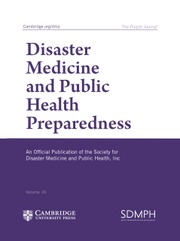No CrossRef data available.
Article contents
Enhancing Preparedness and Response to Flood Disasters: A Scoping Review of Training Activities for Response Staff
Published online by Cambridge University Press: 16 September 2025
Abstract
This study examines the scope and trends of empirical research on training activities for flood disaster response teams.
A scoping review, adhering to Preferred Reporting Items for Systematic Reviews and Meta-Analyses Extension for Scoping Reviews guidelines, was conducted in June 2024 across four electronic databases and grey literature. The analysis included experimental and quasi-experimental studies published since 2005. An initial pool of 1193 studies was identified, 18 met the eligibility criteria and were included in the final analysis.
These studies revealed three key themes: 1) evaluation and improvement of operational procedures, 2) preparation of response teams, and 3) management of health-related issues.
The results highlight the limited availability of empirical evidence in this area, reflecting the relatively small number of studies focusing specifically on training activities for flood disaster response teams. However, research in this field has shown growth since 2010, with a notable integration of educational technologies in most studies. Key training topics include psychological first aid and the evaluation of operational plans. Given the increasing frequency and severity of flood disasters due to global warming, further research is essential to develop and implement effective training programs, enabling response teams to address such emergencies more efficiently and comprehensively.
Information
- Type
- Review Article
- Information
- Copyright
- © The Author(s), 2025. Published by Cambridge University Press on behalf of Society for Disaster Medicine and Public Health, Inc

